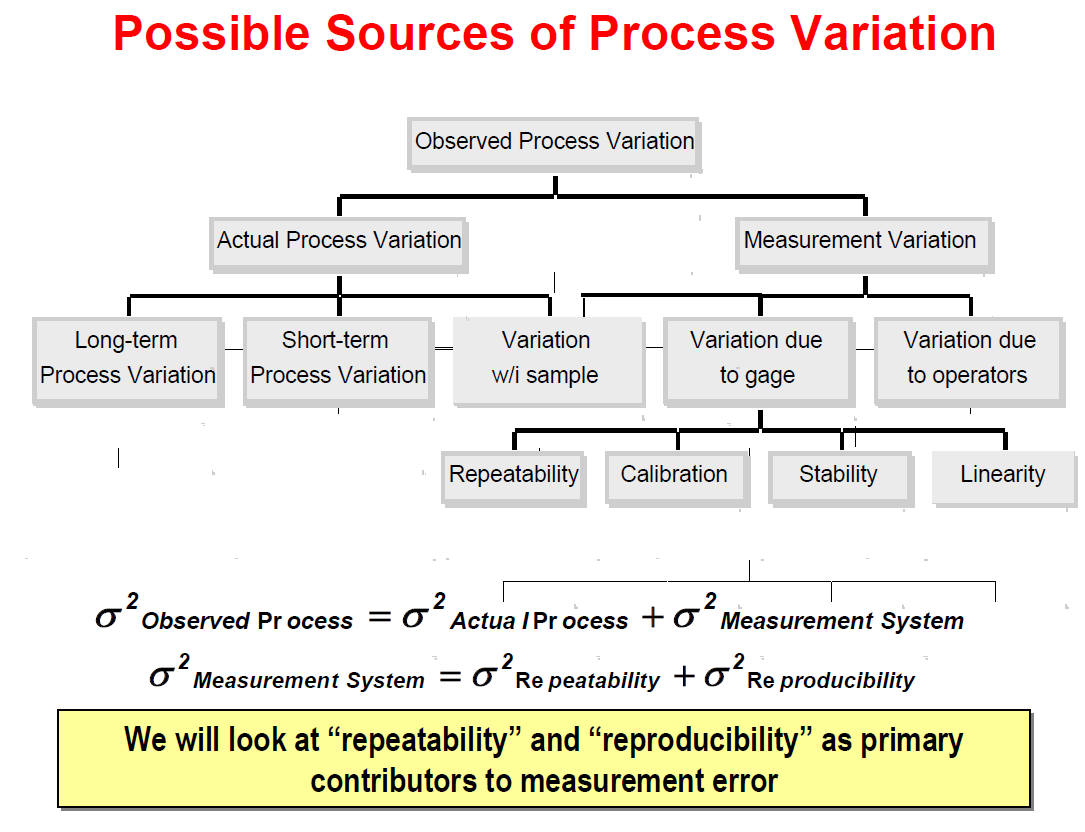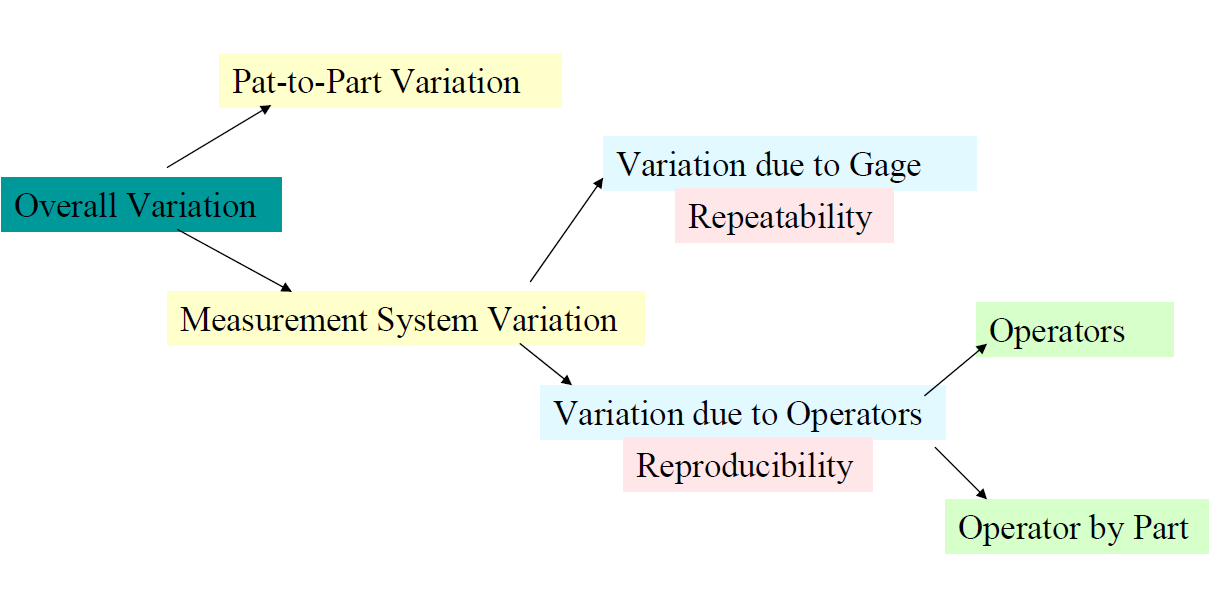Six Sigma: Measure : 4 Measurement System Analysis & Data Collection
Sensitivity Reproducibility Accuracy of Measurement Precision of Measurement Definition of Gage R&R Gage R&R –Repeatability Reproducibility
There is much confusion on measurement terminology. There are four characteristics to examine in a gage system.
Sensitivity
The gage should be sensitive enough to detect differences in measurement as slight as one-tenth of the total tolerance specification or process spread, whichever is smaller. Inadequate discrimination will affect boththe accuracy and precision of an operator’s reported values.
Reproducibility
The “reliability” of the gage system or similar gage systems to reproduce measurements. The reproducibility of a single gage is customarily checked by comparing the results of different operators taken at different times. Gage reproducibility affects both accuracy and precision.
Accuracy of Measurement
•Broken down into three components:
1. Stability: the consistency of measurements over time.
2. Accuracy: a measure of the amount of bias in the system.
3. Linearity: a measure of the bias values through the expected range of measurements.
Precision of Measurement
•Precision, aka Measurement Variation, can be broken down into two components:
1. Repeatability (Equipment variation): variation in measurements under exact conditions.
2. Reproducibility (Appraiser variation): variation in the average of measurements when different operators measure the same part.
There is much confusion on measurement terminology. There are four characteristics to examine in a gage system.
Sensitivity
The gage should be sensitive enough to detect differences in measurement as slight as one-tenth of the total tolerance specification or process spread, whichever is smaller. Inadequate discrimination will affect boththe accuracy and precision of an operator’s reported values.
Reproducibility
The “reliability” of the gage system or similar gage systems to reproduce measurements. The reproducibility of a single gage is customarily checked by comparing the results of different operators taken at different times. Gage reproducibility affects both accuracy and precision.
Accuracy of Measurement
•Broken down into three components:
1. Stability: the consistency of measurements over time.
2. Accuracy: a measure of the amount of bias in the system.
3. Linearity: a measure of the bias values through the expected range of measurements.
Precision of Measurement
•Precision, aka Measurement Variation, can be broken down into two components:
1. Repeatability (Equipment variation): variation in measurements under exact conditions.
2. Reproducibility (Appraiser variation): variation in the average of measurements when different operators measure the same part.

Definition of Gage R&R
•Gage R&R is a method of determining:
–Repeatability
–Reproducibility
Gage R&R –Repeatability
The term “repeatability”refers to:
•The inherent variability of the measuring system
•Variation that occurs when repeated measurements are made of the same item under absolutely identical conditions–Same operator–Same setup–Same units–Same environmental conditions
Gage R&R –Reproducibility
The term “reproducibility”refers to:•The variation that results when different conditions are used to make the measurements–Different operators–Different setups–Different units–Different environmental conditions–Different measurement systems
•Gage R&R is a method of determining:
–Repeatability
–Reproducibility
Gage R&R –Repeatability
The term “repeatability”refers to:
•The inherent variability of the measuring system
•Variation that occurs when repeated measurements are made of the same item under absolutely identical conditions–Same operator–Same setup–Same units–Same environmental conditions
Gage R&R –Reproducibility
The term “reproducibility”refers to:•The variation that results when different conditions are used to make the measurements–Different operators–Different setups–Different units–Different environmental conditions–Different measurement systems
•If the measurement system fails to pass analysis, before collecting data:
–Fix gage
–Fix measurement system
–Train measurement takers
At the conclusion of the Measurement System Analysis, the Project Team should know that:
-The measurement system is capable of gathering data that accurately reflects variation in the process
– If there is measurement error, how big it is and a method of accounting for it
-Measurement increments are small enough to show variation
-Sources of measurement error have been identified
Example of Study Gage R&R: You can read results with below logic in mind:
If the Total Gage R&R contribution in the %Study Var column (% Tolerance, %Process) is:
–Fix gage
–Fix measurement system
–Train measurement takers
At the conclusion of the Measurement System Analysis, the Project Team should know that:
-The measurement system is capable of gathering data that accurately reflects variation in the process
– If there is measurement error, how big it is and a method of accounting for it
-Measurement increments are small enough to show variation
-Sources of measurement error have been identified
Example of Study Gage R&R: You can read results with below logic in mind:
If the Total Gage R&R contribution in the %Study Var column (% Tolerance, %Process) is:
- Less than 10% – the measurement system is acceptable.
- Between 10% and 30% – the measurement system is acceptable depending on the application, the cost of the measuring device, cost of repair, or other factors.
- Greater than 30% – the measurement system is unacceptable and should be improved.
